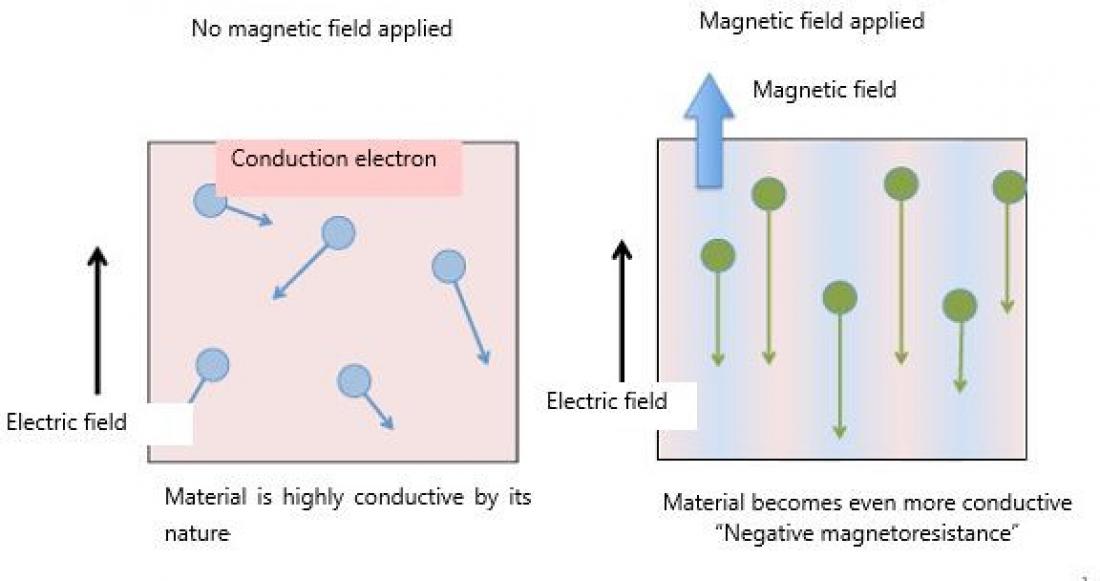A research group consisting of National Institute for Materials Science (NIMS) Quantum Properties Group, the National High Magnetic Field Laboratory (Florida, the United States), the High Field Magnetic Laboratory (The Netherlands), Tokyo Metropolitan University and Kyoto University measured the magnetoresistive effects—change in conductivity in response to an applied magnetic field—using palladium–cobalt oxide (PdCoO2), a non-magnetic, highly conductive material. As a result, when a magnetic field was applied to PdCoO2, the group observed significant phenomena (negative magnetoresistivity), the conductivity greatly increased with increasing magnetic field. This is the first observation of such phenomena in a magnetic and highly conductive material.
------------------------------------------------------------------------------------------------------------------------
Image (left): Models depicting negative magnetoresistivity discovered in this study. Under the condition in which a magnetic field is absent, as shown in the left diagram, conduction electrons can move not only in the opposite direction to that of an electric field but also in other directions. However, when a magnetic field is applied, as shown in the right diagram, the orbitals of electrons are rearranged, making electrons move more readily in the opposite direction to that of the electric field. This latter case can be observed only in materials of very high purity. In this study for palladium cobalt oxide, a magnetic field was applied in a direction perpendicular to the conduction plane of palladium.
-------------------------------------------------------------------------------------------------------------------------
Magnetoresistivity has been applied to many different devices such as hard disks that take advantage of magnetism. Active research is conducted in this field including a search for new materials exhibiting strong magnetoresistance. Negative magnetoresistivity has been observed in magnetic materials and extrinsic semiconductors. However, when a magnetic field is applied to non-magnetic, highly conductive materials (metals with abundant conduction electrons), resistance increases due to increased collisions among conduction electrons in the materials (positive magnetoresistivity). Accordingly, strong negative magnetoresistance had not been observed in these materials.
The research group observed negative magnetoresistivity in PdCoO2, a non-magnetic and conductive material. This material has a layered structure including two-dimensional palladium layers which make the material highly conductive like other metals. In addition, due to lack of magnetism, it had been viewed as an ordinary conductor incapable of exerting negative magnetoresistivity. However, when a magnetic field was applied to the palladium layers in a direction perpendicular to their conduction planes, the research group observed negative magnetoresistive effects in the form of a dramatic increase in conductivity (and a decrease in resistance) along the direction of the magnetic field. The group also identified the mechanism causing these effects by analyzing the electronic state in the magnetic field.
Furthermore, the research group observed similar magnetoresistive effects in platinum cobalt oxide, which is related to palladium cobalt oxide, and strontium-ruthenium oxide, another conductive oxide with a layered structure. These experimental results indicate that negative magnetoresistivity is a universal phenomenon among non-magnetic and conductive materials. In addition to being very interesting from the viewpoint of basic research, these results may also facilitate the formulation of new guidelines in applied fields such as the development of device sensors and the exploration of materials that exert magnetoresistivity through the same mechanism discovered in this study.
A part of this study was supported by the Japan Society for the Promotion of Science’s Grants-in-Aid for Scientific Research on the innovative area of “Topological materials science.”
The original research paper addressing these results is scheduled to be published in the online version of British scientific journal Nature Communications at 19:00 on Tuesday, March 29, 2016 (Japan time).



